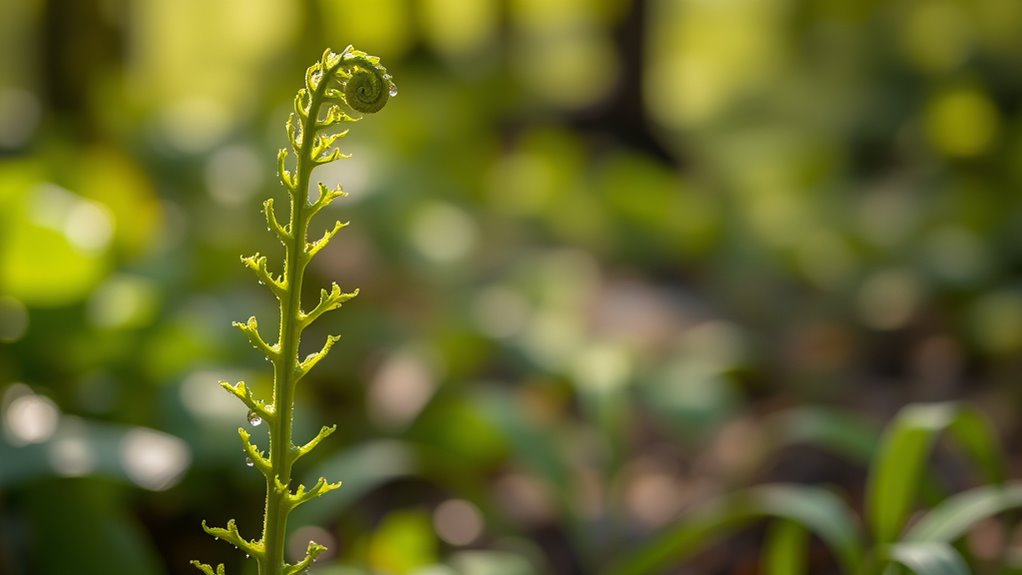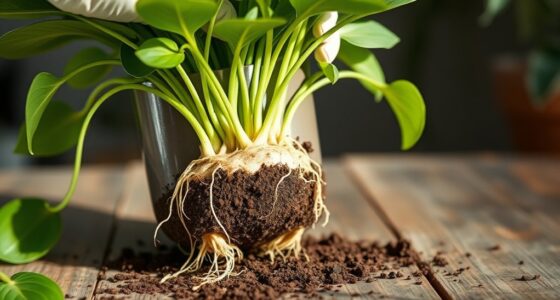Plants can indeed respond to sound and vibrations through specialized structures in their roots and stems, which detect mechanical signals and influence growth, defense, and communication. Studies suggest that vibrations from water flow, wind, or music can prompt changes like faster growth or stronger roots. While research shows some effects, debates continue about how intentional or meaningful these responses are. To uncover more about the fascinating ways plants perceive their environment, explore further insights ahead.
Key Takeaways
- Plants can detect vibrations and sounds through mechanosensitive structures in roots and stems.
- Research shows sound influences plant growth, germination, and flowering, indicating responsiveness to acoustic stimuli.
- Some studies suggest plants emit and perceive sound waves, possibly facilitating communication.
- Responses to sound vary across species and depend on frequency, intensity, and environmental conditions.
- Scientific debate continues over whether plant responses to sound are intentional communication or incidental reactions.
The Science Behind Plant Sensory Abilities

Plants may seem passive, but they are highly sensitive to their environment. Researchers have discovered that plants can respond to external stimuli like plant music, which involves sound waves resonating with their tissues. One key way they sense their surroundings is through root vibrations, which travel through the soil and are detected by specialized cells in the root system. These vibrations can influence growth patterns, signaling the plant to adapt to environmental changes. For example, vibrations caused by water flow or nearby activity can trigger responses in roots, helping plants optimize nutrient uptake or avoid harm. This ability to perceive vibrations underscores the complex sensory systems plants use to monitor their environment, challenging the idea that they are simply passive organisms.
How Do Plants Detect Vibrations?

Despite lacking ears or a nervous system, plants have evolved specialized structures to detect vibrations in their environment. These structures allow them to perceive subtle plant sounds caused by wind, water, or nearby activity. Vibration detection occurs through mechanosensitive cells located in plant tissues, especially in roots and stems. When vibrations occur, these cells respond by triggering biochemical signals that alert the plant to external stimuli. For example, a trembling branch or soil disturbance creates plant sounds that can be detected internally. This ability helps plants respond appropriately—strengthening stems, growing roots, or activating defense mechanisms. Although plants don’t hear like animals, their vibration detection system provides essential information from their surroundings, facilitating communication and survival in a complex environment. Additionally, research suggests that vibrational communication may play a role in plant-to-plant interactions, enhancing their ability to adapt and thrive.
Experimental Evidence of Sound Influence on Plants

You can see that sound can influence plant growth in various ways, with some studies showing it promotes faster or taller development. Experiments using different audio stimuli reveal how specific frequencies or patterns matter, but results can vary widely. This variability suggests that plant responses to sound are complex and depend on many factors. For instance, high-quality research into plant physiology can provide deeper insights into how environmental stimuli like sound interact with plant systems.
Sound-Induced Growth Changes
Research has shown that sound waves can directly influence plant growth, providing experimental evidence of their responsiveness to auditory stimuli. For example, plants exposed to specific sound frequencies often grow taller, develop stronger stems, and produce more leaves. This suggests that sound therapy might enhance plant development, counteracting the negative effects of noise pollution. Imagine a table illustrating different sound treatments:
| Sound Type | Effect on Growth | Duration |
|---|---|---|
| Classical music | Increased height | 30 minutes daily |
| White noise | No significant change | 1 hour daily |
| Nature sounds | Denser foliage | 45 minutes daily |
| Silence | Baseline growth | N/A |
| Noise pollution | Stunted growth | Continuous |
These experiments highlight how sound influences plant growth, emphasizing the importance of sound environment management in agriculture and urban settings. Additionally, understanding the sound environment can help optimize conditions for healthier plant development.
Experiments With Audio Stimuli
Numerous experiments have provided concrete evidence that sound stimuli can directly impact plant growth. Researchers have tested plant music and sound therapy, exposing plants to different audio frequencies and rhythms. In some studies, plants exposed to specific melodies or vibrations showed faster germination, increased biomass, or healthier development compared to controls. Other experiments used sound therapy to stimulate root growth or improve resistance to stress. For example, certain sound frequencies appear to enhance nutrient uptake or activate growth hormones. These findings suggest that plants respond positively to audio stimuli, supporting the idea that sound can influence plant physiology. While the exact mechanisms remain under investigation, the experimental evidence clearly indicates that sound exposure can be a valuable tool in plant cultivation and health management. Additionally, understanding how plant communication occurs within ecosystems may shed light on how sound influences plant interactions with their environment.
Plant Response Variability
How consistently do plants respond to sound stimuli across different species and experimental conditions? The evidence shows variability in responses, influenced by factors like sound frequency and plant species. Some plants exhibit changes in plant gene expression when exposed to specific sound frequencies, indicating a biological response. Others show minimal or no response, highlighting inconsistency. Experimental conditions, such as sound intensity, duration, and environmental factors, also affect outcomes. Here are key points to contemplate:
- Different species react uniquely to the same sound frequency.
- Plant gene expression may change in some species but not others.
- Response magnitude can vary with sound intensity and exposure time.
- Experimental setups influence the reproducibility of results.
- The hours of operation of research labs and facilities can impact the timing and reproducibility of experiments.
This variability suggests that sound’s influence on plants is complex and not yet fully understood.
The Role of Sound in Plant Growth and Development

You might be surprised to learn that sound can influence how plants grow and stay healthy. Vibrations from specific frequencies can promote stronger roots and faster development. Exploring how sound affects plant health opens new possibilities for nurturing better crops and gardens.
Sound-Induced Growth Effects
Research has shown that sound waves can influence plant growth and development in surprising ways. When you explore plant music or vibration therapy, you may notice changes in how plants grow. Sound vibrations can stimulate cell activity, promoting stronger stems and larger leaves. You might observe:
- Increased seed germination rates
- Faster growth cycles
- Enhanced nutrient absorption
- Improved flowering and fruiting
These effects suggest that sound isn’t just background noise—it can actively support plant health. Incorporating gentle music or specific vibration therapy into your care routine could boost your plants’ growth. Interestingly, some studies indicate that foraging behaviors may also be influenced by environmental vibrations, hinting at a broader role of sound in plant ecology. While more research is needed, current evidence points toward sound as a promising tool in horticulture. So, next time you listen to music around your garden, remember—your plants might be responding more than you think.
Vibrations and Plant Health
Vibrations caused by sound waves can directly influence plant health by stimulating growth processes at the cellular level. These vibrations may enhance the uptake of soil nutrients, helping plants develop stronger roots and healthier foliage. When plants receive specific sound frequencies, they often show improved plant coloration, indicating better overall health. Sound-induced vibrations can activate signaling pathways that promote cell expansion and photosynthesis efficiency. As a result, plants become more resilient to stress and disease. Additionally, Natural Language Processing (NLP) techniques are being explored to analyze plant responses to acoustic stimuli, potentially leading to more precise application methods. By improving nutrient absorption and boosting visual health indicators like coloration, sound vibrations serve as a potential tool to optimize plant growth. While more research is needed, evidence suggests that harnessing vibrations could positively impact plant vitality and development.
Types of Sounds That May Affect Plants

Various sounds in the environment can influence plant growth and behavior, even if plants lack ears to hear them. Certain types of sounds may promote healthy development, while others hinder it. For example, sound therapy uses specific vibrations to stimulate plants, potentially boosting growth. Conversely, noise pollution from traffic or machinery can stress plants, impairing their health. You might consider these sound types:
- Soft, harmonic sounds that encourage growth
- Loud, abrupt noises that cause stress
- Continuous background noise from urban areas
- Deliberate sound therapy sessions for plants
While research is ongoing, some evidence suggests plants respond differently to various auditory stimuli. Understanding these sound types can help you create an environment that supports plant vigor and counters the effects of noise pollution. Additionally, paying attention to environmental factors can further enhance plant health and growth.
Theories Explaining Plant Responses to Auditory Stimuli
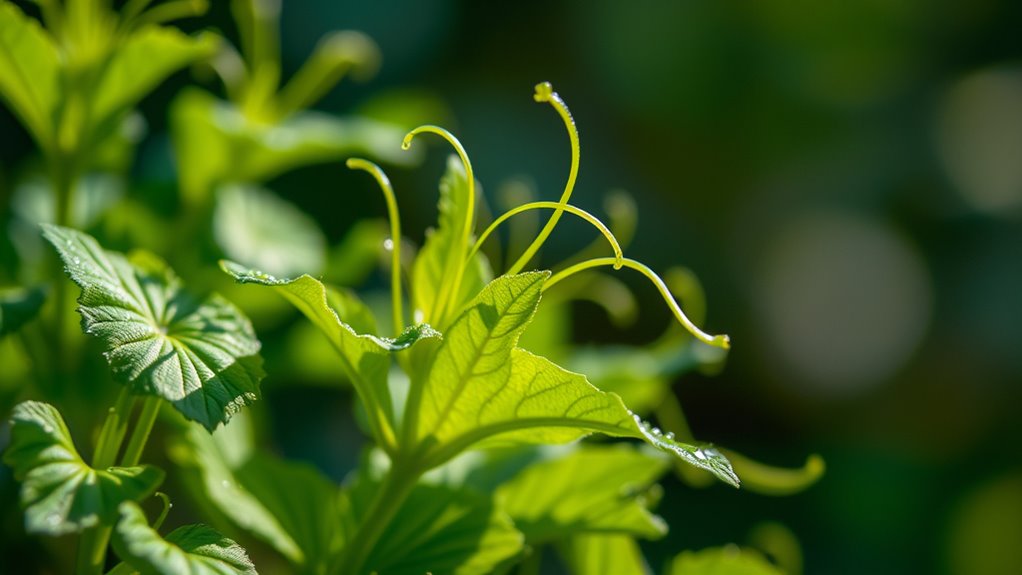
While the exact mechanisms remain uncertain, several theories attempt to explain how plants might respond to auditory stimuli. One idea suggests that plant language involves signals transmitted through sensory mechanisms like vibrations or sound waves. These signals could trigger biochemical responses, influencing growth or defense. Some propose that plants perceive sound as mechanical stimuli, activating cellular pathways. To illustrate these ideas, consider the following:
| Theory | Mechanism | Evidence |
|---|---|---|
| Vibrotaxis | Response to vibrations | Growth changes observed with sound |
| Mechanical Signal | Sound as physical stimulus | Activation of mechanosensitive channels |
| Biochemical Response | Sound triggers chemical signals | Altered gene expression |
| Sensory Mechanisms | Sound perception via receptors | Possible resonance in plant tissues |
These theories highlight potential ways plants interpret sound, hinting at a complex plant language rooted in sensory mechanisms. Additionally, ongoing research into plant sensory mechanisms continues to shed light on how plants might interpret and respond to their environment.
Limitations and Challenges in Studying Plant Sound Perception
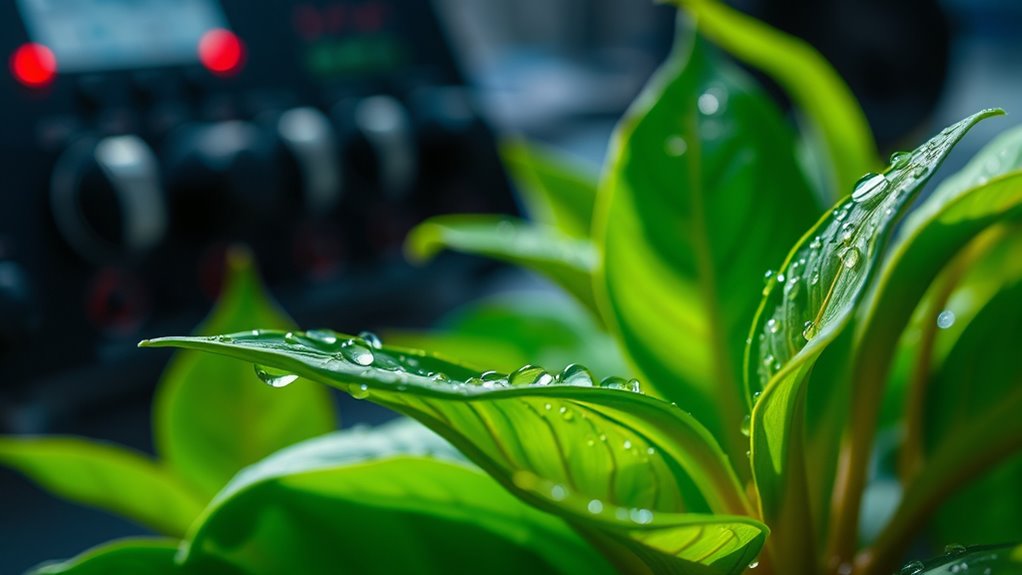
Studying plant sound perception presents significant challenges because detecting and interpreting plant responses to auditory stimuli is inherently complex. Sensor limitations hinder accurate measurement since traditional equipment may not capture subtle vibrations or sound waves emitted by plants. Experimental biases can also affect results, as researchers might unintentionally influence outcomes through their expectations or testing conditions. Additionally, controlling environmental variables like light, temperature, and humidity is difficult, which can skew findings. Variability among plant species makes standardization hard, complicating comparisons across studies. Furthermore, the headphone jacks used in some experimental setups may not be compatible with all devices, affecting data collection accuracy.
- Sensor sensitivity issues can cause missed signals
- Biases may lead to false positives or negatives
- External noise interferes with data accuracy
- Lack of replicable protocols hampers progress
Practical Applications of Sound-Plant Interactions

Sound-plant interactions have the potential to transform how you care for your plants. By applying specific sounds, you can boost greenhouse growth, reduce plant stress, and create innovative garden designs. Exploring these practical uses can help you optimize plant health and garden aesthetics.
Enhancing Greenhouse Growth
Harnessing sound waves offers a promising way to boost plant growth in greenhouses. By optimizing sound frequencies, you can improve photosynthesis efficiency, leading to healthier, faster-growing plants. Additionally, sound treatments can serve as a natural pest deterrent, reducing the need for chemical pesticides. To maximize these benefits, consider the following approaches:
- Use specific sound frequencies to stimulate photosynthesis processes
- Implement background sounds to create an environment less attractive to pests
- Schedule sound exposure during key growth phases for ideal results
- Combine sound therapy with other eco-friendly growing techniques
Adapting sound-based methods can enhance plant health and yield while minimizing chemical use. This innovative approach supports sustainable greenhouse practices and encourages healthier crop production through natural plant responses.
Stress Reduction Techniques
Building on the idea of optimizing sound for growth, applying specific sound techniques can also help reduce stress in plants, promoting healthier development. Using calming sounds or gentle music, similar to meditation techniques, can create an environment that minimizes environmental stressors. These sounds may encourage stress relief in plants by signaling a stable ecosystem, reducing their need to activate defense mechanisms. Incorporate soft, rhythmic tones or nature-inspired melodies to help plants relax and thrive. Consistent, soothing soundscapes can improve overall plant health, especially during stressful conditions like drought or pest attacks. By consciously applying these stress reduction techniques, you can foster a more resilient and vibrant garden, harnessing sound’s calming power to support plant well-being.
Innovative Garden Designs
Have you ever considered how incorporating sound into garden design can create more vibrant and dynamic outdoor spaces? Using sound-plant interactions, you can enhance garden aesthetics while promoting ecological sustainability. Imagine installing gentle soundscapes that attract pollinators or using music-responsive plants to add visual interest. You might also develop gardens that respond to environmental cues, supporting local ecosystems. To achieve this, consider:
- Integrating sound-emitting sculptures that stimulate plant responses
- Choosing plant varieties that react to specific sound frequencies
- Designing sound-based irrigation or lighting systems for energy efficiency
- Creating sensory zones that engage visitors and support pollination
These innovations make your garden more lively and environmentally friendly, blending technology with nature for sustainable beauty and functional design.
Debates and Controversies in Plant Communication Research
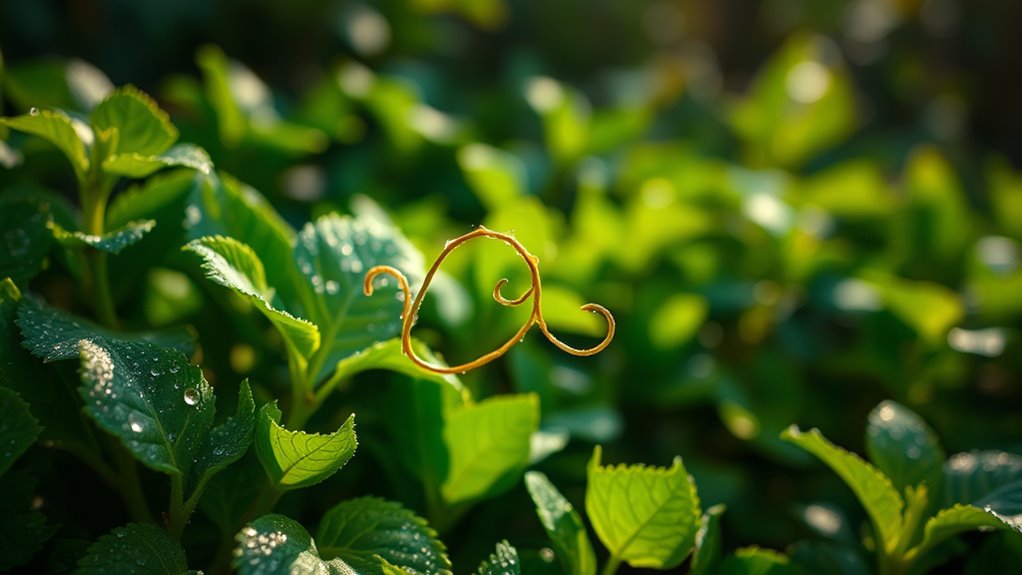
Debates and controversies in plant communication research often center on whether plants genuinely communicate or if observed interactions are merely responses to environmental cues. Some scientists argue that plant language, such as volatile emissions or root signals, indicates a form of communication, while skeptics question if these are simple reactions. The idea of sound symbolism, where plants might respond to or produce specific sounds, sparks further debate. Critics doubt whether plants can interpret or manipulate sound in meaningful ways, or if these phenomena are coincidental. Researchers are divided over whether these interactions demonstrate true communication or are just adaptive responses to stimuli. This controversy challenges assumptions about plant intelligence and pushes scientists to refine methods to better understand plant sensory and signaling systems.
Future Directions in Understanding Plant Sensory Systems

As researchers continue to explore plant sensory systems, future studies are poised to uncover more about how plants perceive and respond to their environment. You might see advances in genetic modifications that enhance plants’ abilities to detect sound, touch, or chemical signals. This research could lead to crops that better withstand environmental stresses or pests, but also raises questions about ecological impacts. To deepen your understanding, consider these directions:
- Developing genetically modified plants with enhanced sensory responses
- Evaluating ecological impacts of sensory-based modifications
- Exploring molecular mechanisms behind plant perception
- Integrating sensory data into sustainable agriculture practices
Frequently Asked Questions
Can Plants Distinguish Between Different Types of Sounds or Only Vibrations?
You might wonder if plants can distinguish between different sounds or just vibrations. Research suggests they have vibration sensitivity, allowing them to detect physical jolts or waves. However, their ability for sound discrimination—telling sounds apart—is still uncertain. While vibrations can influence plant responses, current evidence indicates they respond primarily to vibration sensitivity, rather than interpreting specific sounds. So, plants likely react to vibrations rather than actively differentiating between various sound types.
Do All Plant Species Respond Similarly to Sound Stimuli?
You might think all plants respond the same to sound, but surprisingly, species variability shows otherwise. Evolutionary adaptations shape how each plant perceives and reacts to stimuli, including sound. Some plants might be sensitive, while others ignore it completely. So, just as humans have diverse responses, plants do too—highlighting nature’s fascinating, unpredictable diversity. It’s ironic how we often assume uniformity when evolution guarantees a rich tapestry of responses.
How Quickly Do Plants React to Auditory Signals?
You might wonder how quickly plants react to auditory signals. While plant speed of response varies, most reactions are slow, often taking hours or days. This is because sound perception triggers biochemical changes, not immediate movements. Some studies suggest plants can detect sound vibrations within minutes, but visible reactions like growth changes usually take longer. So, your plants’ response time depends on their species and the type of sound stimulus.
Are Certain Sound Frequencies More Effective in Influencing Plant Behavior?
You might wonder if specific sound frequencies are more effective in influencing plant behavior. Research suggests that certain music therapy and sound wave effects, like gentle vibrations or specific frequencies, can promote plant growth. You should experiment with different sounds, as plants respond variably. While not definitive, evidence indicates that low-frequency sounds and harmonic music could positively impact plants, making them more receptive to sound-based stimuli.
Could Plant Responses to Sound Be Used to Improve Agricultural Practices?
Imagine using sound therapy and vibration signaling to boost crop yields—sounds simple, right? You can harness plant responses to sound, potentially optimizing growth and resilience. While some doubt these methods, research suggests plants may sense vibrations and respond positively. By integrating sound-based techniques into agriculture, you could reduce chemicals and enhance sustainability, making farming more efficient and eco-friendly. This innovative approach could revolutionize traditional practices, offering new opportunities for growers like you.
Conclusion
As you imagine plants gently swaying to unseen melodies, remember they’re more attuned than we think. Their silent whispers and vibrations paint a picture of a world alive with unseen signals, like whispers of the wind guiding their growth. While we’re just beginning to understand this secret language, it’s clear that plants are not just passive beings but vibrant storytellers, waiting for us to listen and see their silent symphony unfold.
